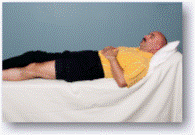It is important to be comfortable as you recover from surgery. When you are resting in bed for long periods of time there are techniques that will make you more comfortable. It is also important to know how much weight you can place on your operated leg. There are three kinds of weight bearing rules you need to know.
Lying Down
 If you are resting for a long period of time, the best way to lie in bed is on your back. Try to keep your knees and toes pointing up. Do not put anything under the knee of your operated side.
If you are resting for a long period of time, the best way to lie in bed is on your back. Try to keep your knees and toes pointing up. Do not put anything under the knee of your operated side.
If you are lying on your side (for short periods of time only) you need to lie on the non-operated side, and you may place one to two pillows between your knees for comfort and to make sure you stay in the position your healthcare team recommends.
If you have had knee replacement surgery, and need to reduce swelling in your leg, you can lie on your back and put a pillow under your ankle to keep your ankle higher than your knee.
Weight Bearing
Weight bearing is the amount of weight you can put on your operated leg. After surgery, you will be told how much weight you can put on your operated leg. The amount of weight bearing will be different for each person.
Ask the therapist or nurse if you don’t know how much weight you can put on your leg.
There are four kinds of weight bearing:
1. No weight bearing
Your cannot put any weight on your operated leg.
2. Foot-to-floor, or toe-touch weight bearing
Your foot on the operated leg lightly touches the floor like a feather.
3. Partial weight bearing
Only a part of your weight can be put on your operated leg – your doctor or therapist will tell you how much weight. Your therapist will help you learn partial weight bearing.
4. Full weight bearing or weight bearing as tolerated (WBAT)
You can put your full weight, or as much as you can handle, on your operated leg when standing or walking.